How to hit all the shots, and make it look easy.
I remember that chip shot I had on the first playoff hole at the 2013 Masters, the one that came right after Angel Cabrera nearly holed out from just behind me? That was a fairly simple chip, but believe it or not, those are the ones I used to struggle with the most. Not that time. I was able to chip it close and save par, and I went on to win the green jacket with a birdie on the next hole.
That was one of many instances over those four days at Augusta where my new short game shined. I’ve been working on it over the past two years with my coach, Brad Malone, and it really came together that week. Another example was on Saturday, when my approach on the first hole missed the green short and right. The pin was back-right on a shelf—very tough spot. Getting it close meant hitting a shot I didn’t have until recently, but I played an aggressive pitch that pulled up next to the hole. Again, I saved par at a critical time.
What I’ve done with my short game is simplify the technique, and it’s made me more confident and aggressive. Follow my tips on chipping, pitching and sand play, and you, too, will make these shots look easy.
CHIPPING
WHAT I USED TO DO
I had a lot of forward lean in my setup, so I’d chip the ball too strong, or I’d decelerate and try to scoop it (right). That’s why I had trouble even on straightforward shots like the one in the playoff at Augusta.
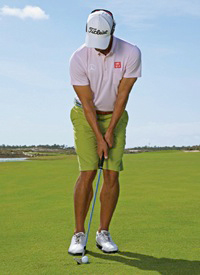
WHAT I DO NOW
Don’t overdo the downward hit. When you chip, you want to set up and swing in the way that gives you the most margin for error. Think how much more confident you’d be if you knew you didn’t have to strike the ball perfectly to hit a decent chip.
That’s why I address the ball in the centre of my stance and keep my weight evenly distributed. The shaft leans only slightly forward. This setup promotes a shallow swing into the ball and lets the wedge do what it’s designed to do: slide along the turf on the back edge of the clubhead.
I think of the swing itself as a mini body rotation back and through—again, very little hand action. Even if I hit it a little fat, the club still gets under the ball.
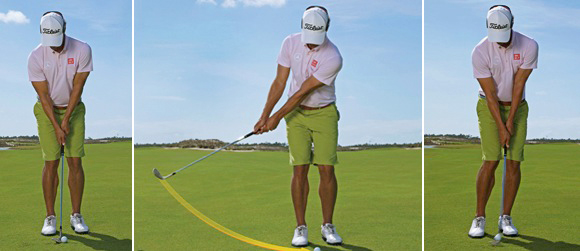
I set my weight 50/50 and play the ball centre to promote a sweeping stroke at impact.
PITCHING
WHAT I USED TO DO
I was really wristy on my pitch shots because I thought I had to create loft and spin. l’d hinge my wrists fully and then have to unhinge them before impact. I never knew how hot the ball was going to come off.
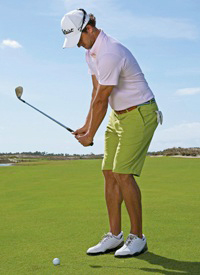
WHAT I DO NOW
Take the hands out of the shot. Distance control is the big thing in pitching, so to get more consistent I’ve worked on quieting my hands and wrists. This might sound funny, but when I do this, I feel as if the ball stays on the clubface a millisecond longer, allowing me to guide it to the target.
My focus in pitching is on rotating my body around my left leg. I start from a slightly open stance, with my weight even and the ball centered. My hands and arms are doing very little as I turn back. Then I rotate my chest toward the target, letting it pull my arms and club along with it. If I want to change the loft or spin, I adjust the clubface or ball position. It’s very seldom that I consciously use any wrist action.
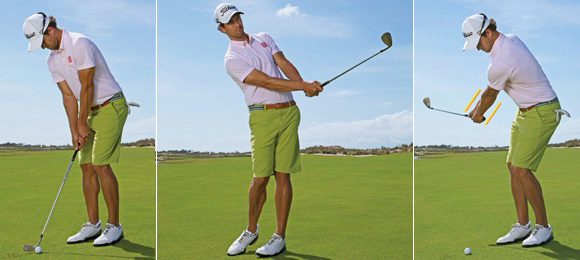
Notice my left leg is straight: It’s acting as a post, and my body is turning around it.
SAND PLAY
WHAT I USED TO DO
My bunker swing looked a lot like my full swing. I’d set up with a square face, and at impact my hands were well ahead of the clubhead—too much digging. On bunker shots, the clubhead should pass the hands earlier.
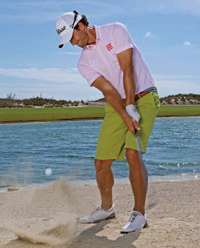
WHAT I DO NOW
Open the face, and make a full swing. From greenside bunkers, I want to swing without holding anything back. That includes letting the clubhead pass my hands through impact. On chips and pitches, my hands stay fairly passive, but in the sand, I definitely use some wrist action.
I set up with the clubface considerably open and the ball up by my front foot. That gives me the confidence that I can make a full backswing and an aggressive downswing without worrying about hitting the ball too far. Unlike the full swing, where the hands lead the clubhead through impact, I unhinge my wrists completely coming down so the clubhead passes my hands. That passing action maximizes loft, so you can hit a high, soft shot.
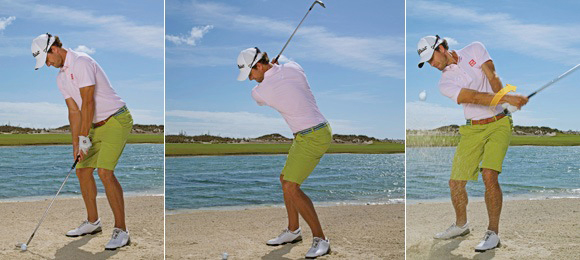
Because I start with an open clubface, I can make a full turn and still hit a short shot.



